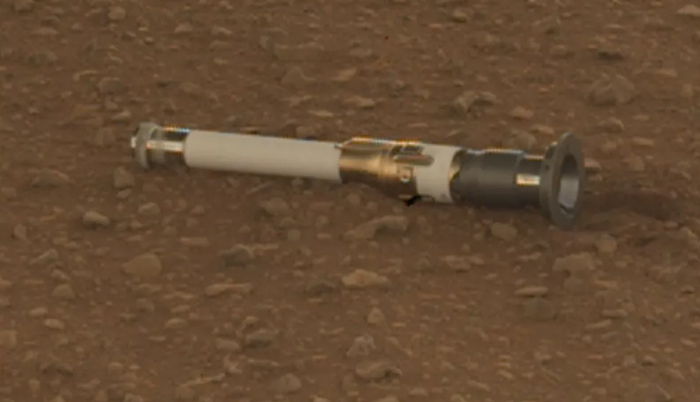![]() Home > Space & Science
Home > Space & Science
Mars Dust Won't Bury Perseverance Rover's Rock Sample Tubes On Martian Surface

The Perseverance rover deposits its first cache of Mars material to return to Earth on Dec. 21, 2022. (Image credit: NASA/JPL-Caltech/MSSS)
![]() December 29th, 2022 | 11:33 AM |
December 29th, 2022 | 11:33 AM | ![]() 1511 views
1511 views
WASHINGTON, D.C., UNITED STATES
'My team's not worried' about dust or wind disturbing the lightsaber-shaped cache tubes, NASA's Perseverance mission wrote on Twitter.
This month, NASA's Perseverance rover has been dropping lightsaber-shaped caches of material on the surface of Mars to lie in wait as backup for a future sample-return mission. Perseverance collects two samples at each location and carries one set with it. If the rover can't bear the samples in its belly to a waiting spacecraft itself, two fetch helicopters will tote the backup surface tubes to the return rocket instead in the 2030s.
The epic NASA-European joint mission will allow researchers on Earth to scrutinize the tubed samples for signatures of life. Given the fetch mission isn't expected to land until the 2030s, however, officials at NASA's Jet Propulsion Laboratory said on Twitter that they've heard public concerns about wind or dust hurting the tubes, or making the caches difficult to retrieve.
"My team's not worried," the official Perseverance account tweeted(opens in new tab) Dec. 23, along with a series of evidence showing why the tubes won't travel far — and how NASA is tracking their deposit locations as the ultimate backup.
Unlike the fictional, powerful wind storm depicted at the start of "The Martian" (2015), the Red Planet has gentle gusts. Due to its thin atmosphere at only one-hundredth the pressure of Earth's at sea level, Mars wind largely is confined to picking up fine sand grains.
"Winds around here can pick up *speed,* but they don't pick up a lot of *stuff.* Think fast, but not strong," the Perseverance account tweeted. In practical terms, winds are not the threat for nuclear-powered missions like Perseverance. The NASA Curiosity rover, for example, is still running after 10 Earth years on Mars with only a thin layer of dust covering the machinery, the account noted.
That said, dust coverage on solar panels (like NASA's recently concluded InSight Mars lander mission) can pose a long-term threat to exploration, as they slowly choke off the supply to solar power — absent a lucky gust of wind. "It's spelled the eventual end of more than one solar-powered explorer," the Twitter thread noted of the dust.
Even for tubes that lie low on the surface, NASA expects they will be "easy to spot" based on examples like older footage from InSight. After four Earth years lying on the Red Planet ground, cables from InSight were admittedly dusty, but still recognizable.
"Not only do we expect the sample tubes not to be covered up," the Perseverance account tweeted alongside a map, "but I'm also very carefully documenting exactly where I put them down. So going back to them again later shouldn’t be an issue."
The backup mission is currently expected to arrive in nine years, or around 2031. Launch opportunities between Earth and Mars arise roughly every two years, giving several chances to send a mission out there before 2040 — assuming that funding for the sample return mission holds and technology development proceeds to plan.
Source:
courtesy of SPACE
by Elizabeth Howell
If you have any stories or news that you would like to share with the global online community, please feel free to share it with us by contacting us directly at [email protected]